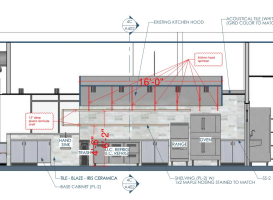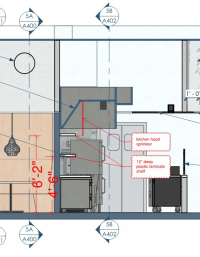Ryan Schultz
SAWHORSE
Is there any code that would prevent adding these types of p-lam shelves under the hood? The only one i know about is referenced below. If this is the only one that applies, it seems we could still keep the lower shelf. 506.5.4 Clearances
Exhaust equipment serving a Type I hood shall have a clearance to combustible construction of not less than 18 inches (457 mm).

 up.codes
up.codes
note: hood is existing, new restaurant tenant only needed range and oven.


Exhaust equipment serving a Type I hood shall have a clearance to combustible construction of not less than 18 inches (457 mm).

Chapter 5 Exhaust Systems: Exhaust Systems, Wisconsin Mechanical Code 2015 | UpCodes
UpCodes offers a consolidated resource of construction and building code grouped by jurisdiction
note: hood is existing, new restaurant tenant only needed range and oven.


